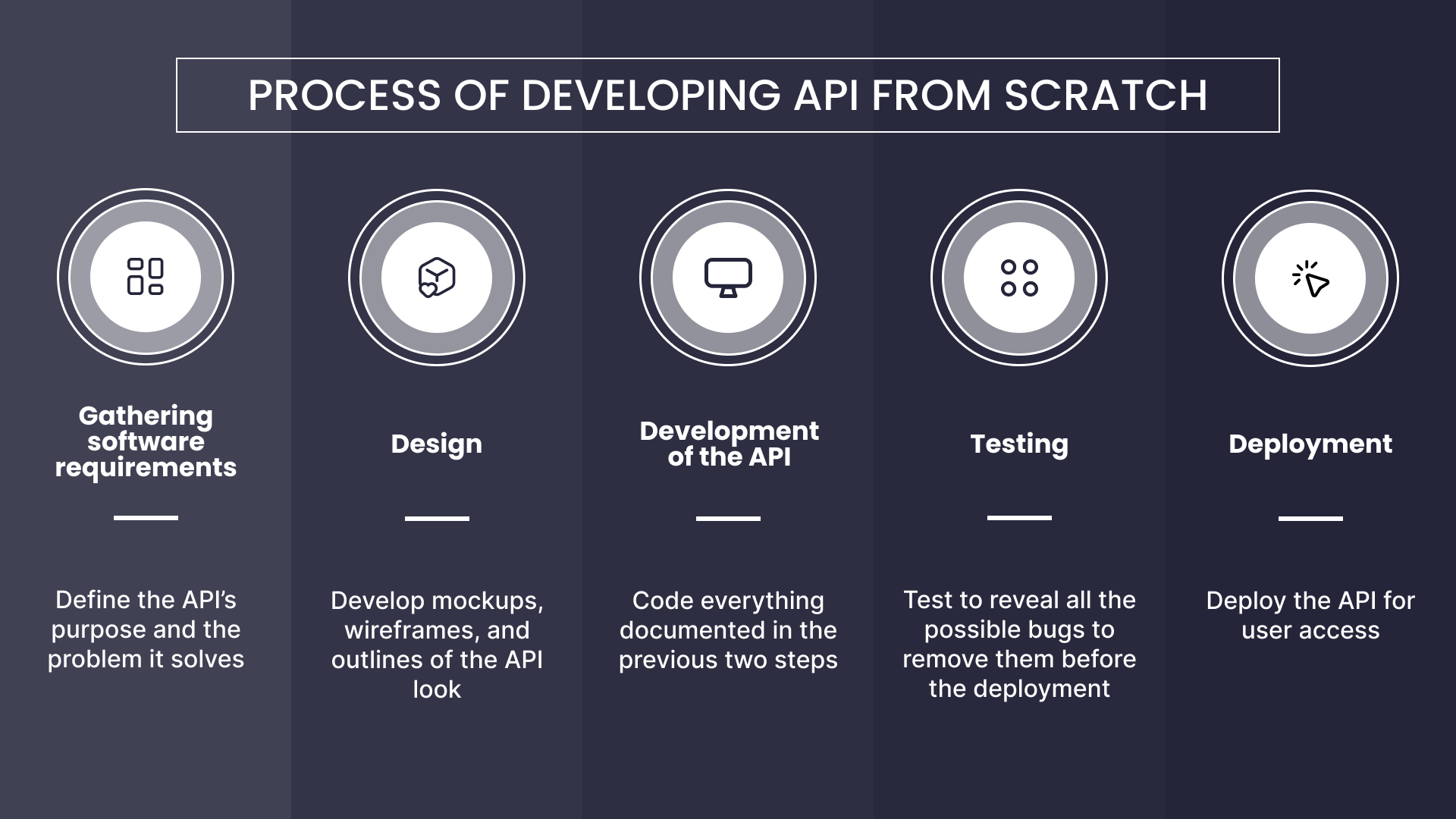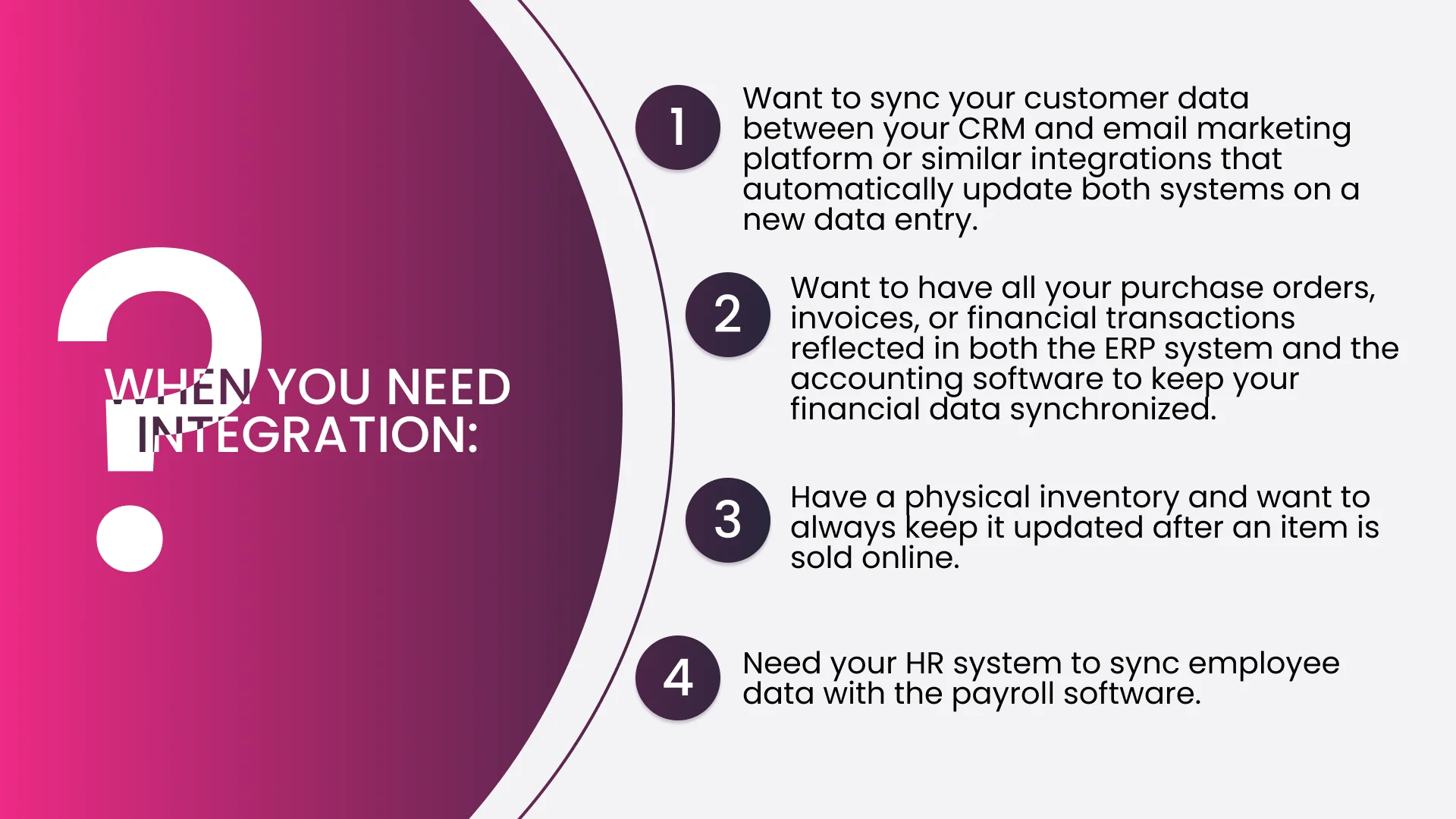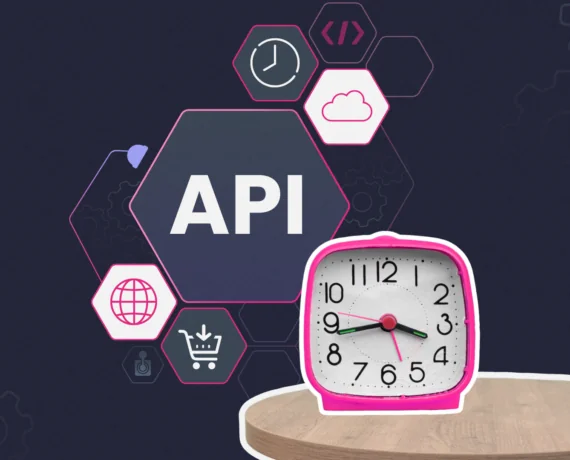Table of Content
- Introduction to Application Programming Interface
- Importance of API
- What is the difference between API and integration?
- API Development from scratch
- Advantages of API development from scratch
- Process of developing API from scratch
- API Integration
- What APIs are the fittest for integration?
- Process of integration APIs
- When to Use API vs. Integration
- Conclusion
Hesitate what is better: develop or integrate?
Book a callUnderstanding the API vs. integration difference and knowing which one to use and how is crucial for building, managing, using, and developing software effectively. Also, it can help you offer a better reference to your team of what you need and want. Besides knowing the difference between api and integration, it’s very important to know how to make use of both, not just one or the other. If you are still trying to understand the difference between API vs. integration and which method is best for your data needs, or you simply want to learn more about each one’s advantages, processes, and situations where you can use them, stick till the end of this article.
Introduction to Application Programming Interface
Definition and Purpose
An Application Programming Interface (API) is a set of defined rules that enables different software components to communicate with each other, exchange data, and request services. Essentially, an API acts as a bridge, allowing various software applications to interact seamlessly. The primary purpose of an API is to facilitate the exchange of data and functionality between different systems, making it easier to integrate multiple applications. API integration refers to the process of connecting these applications or systems using APIs, enabling them to share data and perform actions in real-time. This process is crucial for businesses, as it helps to automate tasks, improve data accuracy, and enhance overall efficiency. By leveraging APIs, companies can streamline their operations, reduce manual processes, and ensure that their software components work together harmoniously.
Importance of API
APIs play a vital role in modern software development, offering numerous benefits and advantages. One of the key benefits of API integration is the improved data exchange between different systems, which enhances collaboration and increases productivity. By integrating multiple APIs, businesses can automate repetitive tasks, significantly reducing the need for manual data entry and thereby improving data accuracy. This automation not only saves time but also minimizes the risk of human error, ensuring that data is consistent and reliable.
Additionally, APIs enable companies to provide better customer experiences by allowing seamless integration with various social media platforms. This integration helps businesses reach a wider audience, improve their online presence, and engage with customers more effectively. The benefits of API integration extend to various aspects of a business’s operations, including enhancing their tech stack, staying competitive in the market, and enabling more efficient workflows.
What is the difference between API and integration?
Before showing you the key difference between API and integration, let’s first get the terms right and make sure we understand what each one does. Let’s first start with an API (Application Programming Interface). An API allows two different software applications to communicate with each other and share data. It basically connects smaller apps to help your main software with different purposes. While an API provides the tools for two systems to exchange information, an integration is connecting those two separate systems so they can work as one. Integrations make everything work smoothly. Here’s a graphic that will better represent the difference between API and integration:

API Development from scratch
Developing the API instead of just integrating the existing one is the right decision if you need:
- A custom user interface must provide users with a unique experience using it. It is important in the travel industry, where travel tech companies want to win the competition with other companies in meeting users’ specific needs and demands. In such a case, it is better to allocate resources to develop it from scratch. A bright example is Airbnb’s user interface, which is intuitive and simple for users;
- Complex business logic is another vital reason for developing APIs on your own, as it demands the creation of unique functionality that specifically your product needs to perform certain actions or provide services;
- Performance-critical APIs like real-time data processing require a high level of performance. For example, in the travel industry, there is flight search, which requires processing large amounts of data in real time to provide users with relevant information about flights.

If you want to develop a custom API that exactly meets your needs and wants but don’t know much about software development or coding at all, check out our custom API development services.
Looking for a tech partner for developing an API?
Best Practices for API Development
To ensure successful API integration, it’s essential to follow best practices for API development. This includes designing a robust API architecture that can handle the demands of your applications and implementing proper testing to ensure reliability and performance. Using secure protocols such as HTTPS is crucial to protect data during transmission and prevent unauthorized access.
API documentation is another critical aspect, as it provides developers with the necessary information to integrate the API with their applications effectively. Comprehensive documentation helps in reducing integration time and ensures that developers can easily understand and use the API.
Furthermore, API gateways can be used to manage and secure API traffic, ensuring that only authorized requests are processed. This adds an extra layer of security and helps in monitoring and controlling the usage of APIs.
When building an API, it’s essential to consider the different types of APIs, including RESTful APIs, SOAP APIs, and others. Each type of API has its own strengths and weaknesses, and the choice of API type will depend on the specific use case and requirements. For example, RESTful APIs are commonly used for web services due to their simplicity and scalability, while SOAP APIs are often used for enterprise resource planning (ERP) systems because of their robustness and security features.
In addition to the technical aspects of API development, it’s also essential to consider the business benefits of API integration. API integration can help businesses to improve their customer experience, increase revenue, and reduce costs. By integrating with social media platforms, businesses can reach a wider audience and improve their online presence. By integrating with accounting software, businesses can automate financial tasks and improve their financial management. By integrating with marketing platforms, businesses can enhance their marketing efforts and increase their revenue.
Overall, API integration is a critical component of modern software development, enabling businesses to automate tasks, improve data accuracy, and enhance overall efficiency. By following best practices for API development and considering the different types of APIs and their use cases, businesses can ensure successful API-based integrations that drive business value and improve customer experiences.
Advantages of API development from scratch
The first and foremost advantage of developing APIs from scratch is greater control over the functionality. It means you can manipulate each aspect and ensure that it works exactly as you need and without any restrictions or limits as API integrations have. A web server plays a crucial role in this process by acting as a mediator between applications and external programs. It depends on the project, but for the travel industry, greater control over an API can positively impact the user experience.
Customization. You need a custom API that is designed to your requirements to make a unique user experience, meet the project’s specific needs, and satisfy the target audience. Highlighting the importance of API integration, integrating multiple APIs is essential for building efficient, secure, and scalable applications. While the existing API already has a designated and developed feature that may meet your needs with limited functionality, a developed one gives you the freedom to customize it as you need and want.
Process of developing API from scratch
With all the advantages of the developed API, it is crucial to understand the development process, its demands, and its timescale to objectively compare it with API integration.
Helps to understand the purpose of the API and what problem it solves. It is an essential part of the development process as it defines the whole process.
-
Design
After collecting and approving the requirements of the API, the next step is its design. It involves developing mockups, wireframes, and outlines of the API look.
-
Development of the API
The core process of actually creating the API. This step involves coding everything that was documented in the previous two steps.
-
Testing
A crucial step as proper testing ensures that the API will be as high quality as possible. During this step, the team conducts manual and automated testing to reveal all the possible bugs to remove them before the deployment. Remember that the sooner you find bugs, the easier and cheaper it is to fix them.
-
Deployment
The final step is to deploy the API for the users.
Examples of successful projects that benefited from developing an API from scratch instead of integrating:
- Custom Search Algorithm in AirBNB. This developed-from-scratch feature provides users with personalized accommodations separated from competitors.
- Personalized deals in HotelTonight. Based on machine learning algorithms, it recommends hotels according to users’ preferences. It allows the product to provide users with a highly personalized experience.
- Price forecasts from Kayak. It predicts an increase or decrease in prices for flights or hotels, which helps customers to save money on travel.
- AI-powered flight booking in Hopper. This feature allows customers to find the most profitable deals by finding the best combination of price, convenience, and flexibility.
API Integration
Despite all the advantages and profits of developing APIs from scratch, API integration has the following reasons to be chosen:
- Significantly reduced time of development, as integrating APIs saves time and resources thanks to already built functionality and services, which helps to speed up the development;
- A cost-effective solution in comparison to development from scratch;
- Specialized expertise and availability of a wide range of features and solutions, which can be even more useful than a team can develop in-house;
- Improved reliability and scalability.
Need help with API integration? Here’s our custom API integration service.
Let’s talk about your project? Feel free to ask any additional questions you might have. Our experts will be glad to assist you.

What APIs are the fittest for integration?
API integration services offer a large amount of APIs to integrate, but some of the most popular that people use the most are:
- Payment processing integrations: These allow a secure and efficient way to process payments using a range of the most popular and comfortable payment options for clients by utilizing RESTful APIs, which follow HTTP protocols and include requests like GET and POST;
- Mapping and location services: It is often used in apps for delivery services, ride-sharing, or even travel-related apps. These provide real-time geographical data that allows the app to give you personalized services. For instance, the Google Maps API enhances functionality by providing static and interactive maps, directions, and points of interest, which is particularly useful in ride-share and delivery services;
- Social media integration: Mostly effective for marketing, user engagement, and authentication purposes. This can enable users to log in and interact with social media from within the app.
Have a Property Management System and don’t know which APIs you need? Here’s a guide on all the API property management information you need.
Process of integration APIs
Integrating APIs is less daunting than actually developing your own, so if you believe that this is more beneficial for your needs, here are the steps you should take to integrate an API to your software:
- Researching available APIs: Find an API that fully meets your needs and demands. Compare them based on features, pricing, and ease of use.
- Considering the fittest API: To make the right decision, keep in mind the following factors: the quality of documentation, support, maintenance, and compatibility with your tech stack.
- Integrating the API: This includes setting up the API, configuring it, and connecting to your codebase. Utilizing reusable code snippets can streamline this process by providing efficiency, reliability, and consistency.
- Testing the integration: This is the last but not the least important step where you ensure that the API integration work is successful and the feature works as expected and correctly.
When to Use API vs. Integration
Now that you know more about each of these two approaches, let’s help you decide which one to use and when, depending on your specific needs, same as if you were considering OTA vs booking engine. Firstly, some factors to consider are a scope of communication, level of customization, and frequency of interaction, so let’s take them one by one: Additionally, understanding API integration best practices is crucial for successful implementation.
- Scope of communication. If you really need to access and modify specific functions or data in another system, use an API. On the other hand, if you need to connect systems or applications entirely to make them work together, exchange data, maintain workflows over time, and enable social media integrations, use integration.
- Level of customization. Use an API if your software requires a lot of customization and flexibility to access specific services or functionalities between systems. Use integration if you are okay with maintaining an ongoing connection between platforms with minimal to no customization.
- Frequency of interaction. An API is a one-time or occasional solution that usually helps with requesting data on demand, such as retrieving location information from a user. An integration is for continuously exchanging data and automation, such as constantly having data synched between CRM and the marketing platforms.
To make this an even easier choice, here are some real-world scenarios that you might position yourself in or are similar to your needs:
You need an API if you…
- Need to fetch data from external systems, like a news app that constantly pulls the latest articles from different sources.
- Want third-party authentication and allow users to log in to your app using their third-party social media accounts.
- Send data to any service, like having an SMS provider API that sends order confirmation text messages.
- Have real-time data updates, like a stock trading app that always shows you market data in real-time.

You need integration if you…
- Want to sync your customer data between your CRM and email marketing platform or similar integrations that automatically update both systems on a new data entry.
- Want to have all your purchase orders, invoices, or financial transactions reflected in both the ERP system and the accounting software to keep your financial data synchronized.
- Have a physical inventory and want always to keep it updated after an item is sold online.
- Need your HR system to sync employee data with the payroll software.

Need Help with Travel and Booking APIs?
Download this free guide to discover more about APIs, where to find the documentation, main travel and booking API types, and how to select the right API for your needs.
Travel and Booking APIs: Сonnectivity Landscape


Conclusion
Hope we made it clear that you shouldn’t choose one or the other. It’s true that an API is not an integration, and an integration is not an API, but they work in tandem and each has its own purposes. The question shouldn’t be “should I use API vs. integration?” but rather, how can you better make use of both and how to blend them into your system or software to take advantage of what they can do together.




